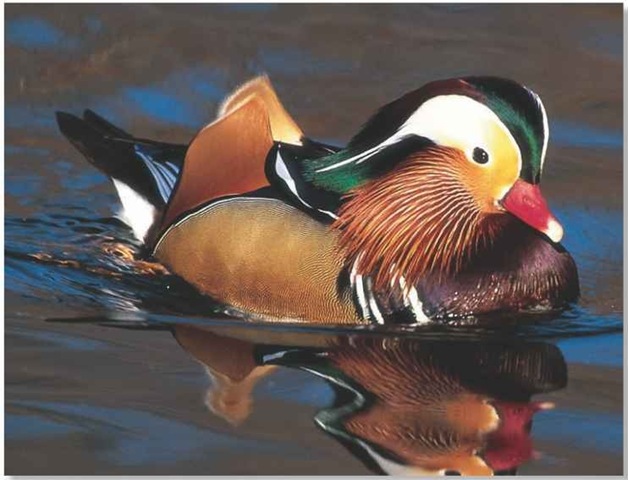ORDER
Anseriformes
FAMILY
Anatidae
GENUS & SPECIES
KEY FEATURES
Extravagant plumage of the drake (male) makes .
it one of the most easily recognized of all ducks t Native to Asia, but escapees from waterfowl
collections established populations in Britain t Prefers wooded habitats near water and usually nests in tree holes
WHERE IN THE WORLD!
Occurs naturally in eastern China, eastern Russia and Japan; feral populations exist in parts of Europe — the majority in southeast England
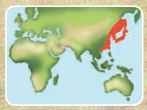
LIFECYCLE
Though it seldom strays far from rivers and lakes, the mandarin duck is just as much a woodland bird as a waterfowl, adapted for flying, perching and nesting among trees.
Habitat
The mandarin duck’s natural haunts lie in broad-leaved, temperate forests of northeast Asia. It typically lives along forest streams or pools lined with thick bankside vegetation (trees, shrubs or reeds). Open ground and broad expanses of water are usually avoided, but small flocks do enter rice fields to feed after breeding. Birds from the north of the range migrate south each year to spend the winter in the milder climate south of China’s Yangtze River:
As many as 300-400 pairs live in the wild in Britain. Escapees from collections have established a number of breeding areas; colonies exist in most counties of southeast England, as well as sites in Norfolk, Cheshire, Gloucestershire and Tayside.
Ideal home
The mandarin duck favors woodland near water.
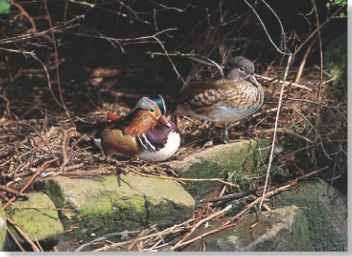
Conservation
The status of the mandarin duck in its Asian homeland is unclear — few studies have been undertaken there. Because of forest clearance and other habitat disturbances in Asia, conservationists suspect its numbers are declining. However, the wild population in Britain is slowly on the rise.
Food & feeding
The mandarin duck finds food both in and out of the water. It forages among debris on the bank, dabbles at the water’s edge or while swimming and occasionally up-ends to reach deeper, submerged food.
Vegetation makes up the bulk of its diet, but the duck will also snap up small creatures (mostly insects); at certain times of the year, animal food predominates. In early autumn, land snails are an important food source. Flocks studied in Russia eat a variety of seeds (including those from aquatic plants), acorns, insects (such as beetles) and small fish. In Britain, the summer diet consists of waterside and aquatic insects; acorns, beechmast and chestnuts provide sustenance the rest of the year.
Feeling peckish
Though known as a surface-feeding duck, the mandarin duck feeds in a variety of ways in and out of the water.
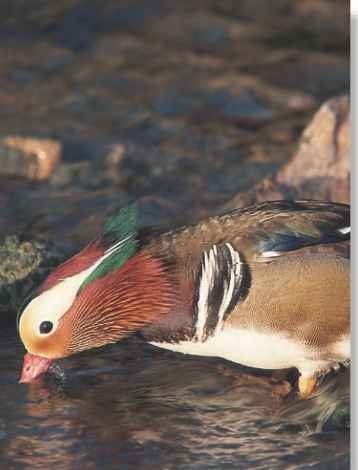
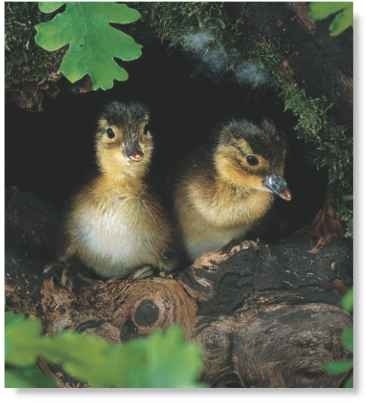
Behavior
Outside the breeding season, when pairs have finished tending their nests, mandarin ducks are social birds that gather in flocks (sometimes more than 60).The duck is most active in mornings and evenings, but feeding continues intermittently throughout the day and night. The mandarin duck is perfectly at home on the water or land, both swimming and walking with ease.
The agility of the mandarin duck extends to its power of flight. With strong, rapid wing-beats, it can rise steeply into the air from the water surface or land. This, and its ability to twist and turn tightly in flight, lets the duck negotiate its way at speed through the confined spaces of its woodland home.
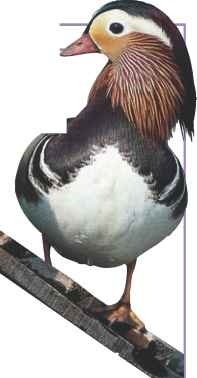
A Sitting pretty” Perching ducks take their name from their ability to “sit” on slender branches.
Breeding
Antics of courtship take up a good deal of a mandarin duck’s time. Starting as early as September, well before the spring mating season, flocks of drakes gather for communal displays designed to impress females.
By spring, most females will have selected a partner; the pairs engage in further displays to strengthen their bonds prior to mating. During the nesting period, the drake stays nearby while the female incubates the eggs. A few days after hatching, the ducklings feed themselves. In six weeks, they’re fully independent.
the hole story
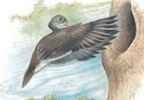
Tree house…
Old trees typically provide the preferred nesting cavities. The favorite nest site is a hole several feet above the ground.
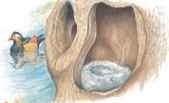
Home-making…
No nesting material is taken into the hole. The female uses her body to mold a depression in debris already there and lines it with feathers.
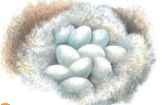
Egg factory
Laying at a rate of one per day, the female produces 9-12 eggs. Once the last is laid, the female begins a four-week stint of incubation.
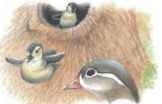
Flying the nest
Shortly after hatching, ducklings scramble to the light and launch themselves from the nest entrance under the watchful eye of mother.
• The first captive Si mandarin ducks were brought to Britain as early as 1747. In 1971, the species was formally accepted on the list of Britain’s wild birds.
• A mandarin duck that escaped from London’s St. James’s Park in 1930 turned up months later in Hungary, 900 miles away.
• In ancient China, the mandarin duck was a symbol of faithfulness, and newlyweds were presented with a pair of live ducks as a good luck token.
PROFILE
Mandarin Duck
With rich colors, ornate patterns and fanciful “whiskers” and “sails,” the male mandarin duck is one of the most beautiful of all waterfowl.

Creature comparisons
The wood duck of North America is the mandarin duck’s cousin. It, too, is a woodland dweller that nests in tree holes; it is also a popular captive bird in Europe. Though similar in
size and shape to the mandarin drake, the male has plumage embellished with glossy greens and browns and bold, white stripes. The female, like the mandarin duck, is mostly gray-brown.
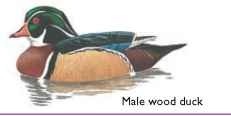
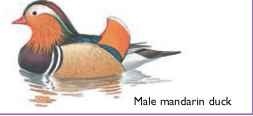
| VITAL | |
| STATISTICS | |
| Weight | 1-1.5 lbs. |
| Length | 16-20″ |
| Wingspan | 27-30″ |
| Sexual Maturity | 1 year |
| Breeding Season | Spring |
| Number of Eggs | 9-12 |
| Incubation Period | 4 weeks |
| Fledging Period | 6 weeks |
| Breeding Interval | 1 year |
| Typical Diet | Seeds and nuts; some insects and snails |
| Lifespan | 3-6 years |
RELATED SPECIES
• The mandarin duck is one of 13 species of perching ducks and perching geese in the Cairinini tribe. Different species are scattered across the globe, but all share adaptations to live in wooded habitats. The largest is the spur-winged goose of Africa; others include the muscovy duck of Central and South America, the African pygmy goose and maned wood duck of Australia.
